Cassini and the ice volcanoes of Titan!
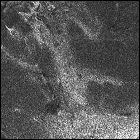 A billion miles from the sun, you don’t need molten lava for volcanoes – you just need subsurface ice to warm up and erupt as water. That’s what NASA scientists think they’ve spotted in a radar image of the surface of Saturn’s moon Titan sent back in late October by the Cassini unmanned probe. A bright, flow-like feature may be indicative of something oozing out onto Titan’s surface from below – and at the frigid temperatures experienced in Saturn’s orbit, ice volcanoes are more likely than the molten rock variety seen on Earth and Mars. If confirmed, this wouldn’t be the first “ice volcano” found in our solar system; Voyager 2 had already spotted an eruption on the surface of Neptune’s largest moon, Triton, as it swung by in August 1989.
A billion miles from the sun, you don’t need molten lava for volcanoes – you just need subsurface ice to warm up and erupt as water. That’s what NASA scientists think they’ve spotted in a radar image of the surface of Saturn’s moon Titan sent back in late October by the Cassini unmanned probe. A bright, flow-like feature may be indicative of something oozing out onto Titan’s surface from below – and at the frigid temperatures experienced in Saturn’s orbit, ice volcanoes are more likely than the molten rock variety seen on Earth and Mars. If confirmed, this wouldn’t be the first “ice volcano” found in our solar system; Voyager 2 had already spotted an eruption on the surface of Neptune’s largest moon, Triton, as it swung by in August 1989.

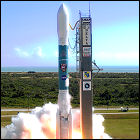 NASA successfully launches the Swift unmanned deep space observatory after a small delay. Carrying three different instrument packages, Swift’s mission is specifically to observe, categorize and study the aftereffects of gamma ray bursts. The satellite is designed to aim itself at any such bursts that it detects within mere seconds so it can catch the short-lived aftereffects and relay its findings to ground controllers. It is believed that some of the bursts are caused by the dying collapse of stars, and possibly the formation of black holes, and as such may be some of the most powerful energy releases known in nature. Swift is expected to observe as many as 100 gamma ray bursts per year.
NASA successfully launches the Swift unmanned deep space observatory after a small delay. Carrying three different instrument packages, Swift’s mission is specifically to observe, categorize and study the aftereffects of gamma ray bursts. The satellite is designed to aim itself at any such bursts that it detects within mere seconds so it can catch the short-lived aftereffects and relay its findings to ground controllers. It is believed that some of the bursts are caused by the dying collapse of stars, and possibly the formation of black holes, and as such may be some of the most powerful energy releases known in nature. Swift is expected to observe as many as 100 gamma ray bursts per year.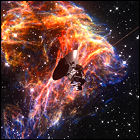 Launched ahead of its identical twin, Voyager 1, in 1977, NASA’s Voyager 2 spacecraft surpasses its 10,000th day in deep space. At 11 billion miles from Earth, Voyager 2 is one of the most distant human-made objects in space, surpassed only by Voyager 1. Both Voyagers are expected to function well into the 2020s, and are expected to have left the solar system to enter interstellar space by then.
Launched ahead of its identical twin, Voyager 1, in 1977, NASA’s Voyager 2 spacecraft surpasses its 10,000th day in deep space. At 11 billion miles from Earth, Voyager 2 is one of the most distant human-made objects in space, surpassed only by Voyager 1. Both Voyagers are expected to function well into the 2020s, and are expected to have left the solar system to enter interstellar space by then.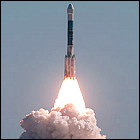 After months of delays in development of its elaborate guidance software system, NASA’s Deep Impact unmanned space probe is launched on a mission to intercept, and fire an impactor into, Comet Tempel 1 half a year later. In order to catch up with the comet, Deep Impact is lofted into orbit by a Delta II rocket, which puts the spacecraft on a precise course at a speed of roughly 64,000mph. Deep Impact will fire the impactor into the comet in July to study the distribution and composition of the debris scattered by the resulting impact.
After months of delays in development of its elaborate guidance software system, NASA’s Deep Impact unmanned space probe is launched on a mission to intercept, and fire an impactor into, Comet Tempel 1 half a year later. In order to catch up with the comet, Deep Impact is lofted into orbit by a Delta II rocket, which puts the spacecraft on a precise course at a speed of roughly 64,000mph. Deep Impact will fire the impactor into the comet in July to study the distribution and composition of the debris scattered by the resulting impact.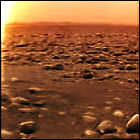 The European Space Agency’s Huygens probe successfully lands on Saturn’s largest moon, Titan, gathering measurements and taking mind-boggling images from the sky all the way down to the surface. Perhaps the biggest discovery of the initial pictures is an aerial view of what appear to be tributaries leading to a large body of liquid – an almost delta-like region as viewed from the sky. (Thanks to Titan’s thick atmospheric haze, its surface has never before been seen.) Huygens itself manages to touch down on dry land, on a plain scattered with chunks of ice, slowed to only 15 miles per hour by parachutes during its descent (despite upper-level winds estimated at around 300mph). Even if Huygens had splashed down in a body of liquid, the probe is designed to stay afloat.
The European Space Agency’s Huygens probe successfully lands on Saturn’s largest moon, Titan, gathering measurements and taking mind-boggling images from the sky all the way down to the surface. Perhaps the biggest discovery of the initial pictures is an aerial view of what appear to be tributaries leading to a large body of liquid – an almost delta-like region as viewed from the sky. (Thanks to Titan’s thick atmospheric haze, its surface has never before been seen.) Huygens itself manages to touch down on dry land, on a plain scattered with chunks of ice, slowed to only 15 miles per hour by parachutes during its descent (despite upper-level winds estimated at around 300mph). Even if Huygens had splashed down in a body of liquid, the probe is designed to stay afloat. After months on a precise interception course, NASA’s unmanned Deep Impact space probe meets up with Comet Tempel 1, firing a impactor into the comet’s nucleus to study the distribution and composition of the debris scattered by the resulting impact. The impactor had been released by the flyby spacecraft six days earlier, and transmitted its images and readings to the flyby vehicle, which records them and retransmits them to ground controllers on Earth. The two vehicles’ on-board software tracks the comet so precisely that the impact happens within a second of the anticipated timeline in the mission plan, kicking up enough cometary dust to obscure the view of the crater left on the comet’s nucleus. Following the Tempel 1 mission, the still-intact Deep Impact flyby vehicle is redirected for future missions to other objects in the solar system.
After months on a precise interception course, NASA’s unmanned Deep Impact space probe meets up with Comet Tempel 1, firing a impactor into the comet’s nucleus to study the distribution and composition of the debris scattered by the resulting impact. The impactor had been released by the flyby spacecraft six days earlier, and transmitted its images and readings to the flyby vehicle, which records them and retransmits them to ground controllers on Earth. The two vehicles’ on-board software tracks the comet so precisely that the impact happens within a second of the anticipated timeline in the mission plan, kicking up enough cometary dust to obscure the view of the crater left on the comet’s nucleus. Following the Tempel 1 mission, the still-intact Deep Impact flyby vehicle is redirected for future missions to other objects in the solar system.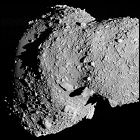 The Japanese unmanned space probe Hayabusa arrives at its destination, asteroid 25143 Itokawa, from which it will gather a sample of material for return to Earth and attempt to deploy a mini-rover. Hayabusa settles into an orbit around the sun parallel to Itokawa, rather than orbiting the asteroid itself, and maintains an initial distance of roughly 12 miles.
The Japanese unmanned space probe Hayabusa arrives at its destination, asteroid 25143 Itokawa, from which it will gather a sample of material for return to Earth and attempt to deploy a mini-rover. Hayabusa settles into an orbit around the sun parallel to Itokawa, rather than orbiting the asteroid itself, and maintains an initial distance of roughly 12 miles.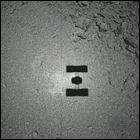 The first attempt to maneuver the unmanned space probe Hayabusa close enough to scoop up a sample of material from the surface of asteroid 25143 Itokawa is aborted by ground controllers at the Japanese space agency, JAXA. The spacecraft’s navigational system finds it difficult to maintain a precise lock on the elongated asteroid, so its automatic safety systems abort the approach to preserve Hayabusa intact. Another attempt to bring Hayabusa close enough to gather material from Itokawa’s surface will be made a week later.
The first attempt to maneuver the unmanned space probe Hayabusa close enough to scoop up a sample of material from the surface of asteroid 25143 Itokawa is aborted by ground controllers at the Japanese space agency, JAXA. The spacecraft’s navigational system finds it difficult to maintain a precise lock on the elongated asteroid, so its automatic safety systems abort the approach to preserve Hayabusa intact. Another attempt to bring Hayabusa close enough to gather material from Itokawa’s surface will be made a week later.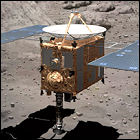 A second attempt is made by the Japanese Aerospace Exploration Agency to bring its unmanned space probe, Hayabusa, close enough to gather a sample of surface material from asteroid 25143 Itokawa. It attempts to deploy a mini-rover called Minerva to explore Itokawa from the surface, but a glitch results in a trajectory that leaves Minerva tumbling into space, never to reach Itokawa. Hayabusa lands on Itokawa’s surface itself, though mission controllers don’t realize this for several more days. Contact is lost with Hayabusa for a short while, and when it is regained, the vehicle has left the surface and gone into safe mode.
A second attempt is made by the Japanese Aerospace Exploration Agency to bring its unmanned space probe, Hayabusa, close enough to gather a sample of surface material from asteroid 25143 Itokawa. It attempts to deploy a mini-rover called Minerva to explore Itokawa from the surface, but a glitch results in a trajectory that leaves Minerva tumbling into space, never to reach Itokawa. Hayabusa lands on Itokawa’s surface itself, though mission controllers don’t realize this for several more days. Contact is lost with Hayabusa for a short while, and when it is regained, the vehicle has left the surface and gone into safe mode.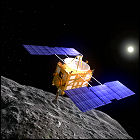 JAXA’s unmanned Hayabusa spacecraft fires its ion engines to depart asteroid 25143 Itokawa, embarking on a five-year trek back to Earth to return surface samples it obtained of the asteroid. Hayabusa has experienced numerous technical glitches, and continues to experience further problems, including a total loss of contact with Earth for several weeks. Only two out of the vehicle’s four ion engines are still functional, and its battery system is only partially reliable, but it is carrying its precious cargo of the first sample material from an asteroid back to Earth.
JAXA’s unmanned Hayabusa spacecraft fires its ion engines to depart asteroid 25143 Itokawa, embarking on a five-year trek back to Earth to return surface samples it obtained of the asteroid. Hayabusa has experienced numerous technical glitches, and continues to experience further problems, including a total loss of contact with Earth for several weeks. Only two out of the vehicle’s four ion engines are still functional, and its battery system is only partially reliable, but it is carrying its precious cargo of the first sample material from an asteroid back to Earth.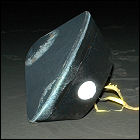 NASA’s unmanned Stardust space probe successfully returns its samples of comet and interstellar dust to Earth. A few minutes after 5:00am Eastern time, the Stardust sample return capsule makes a soft landing in Utah, its record-setting 29,000mph return to Earth slowed by a series of parachutes. (Before Stardust’s return, the fastest vehicle to enter Earth’s atmosphere was the capsule bringing home the crew of Apollo 10 in May 1969.) It is hoped that analysis of the tiny particles captured in cakes of a special porous material called aerogel will shed some light on the origins of the solar system. The “mother ship” portion of the Stardust probe is left on a course that will put it into a permanent orbit around the sun. Stardust was launched in February 1999, and gathered its samples from the cloud of gas and dust surrounding Comet Wild-2 in January 2004, zipping through the comet’s coma at 13,000mph.
NASA’s unmanned Stardust space probe successfully returns its samples of comet and interstellar dust to Earth. A few minutes after 5:00am Eastern time, the Stardust sample return capsule makes a soft landing in Utah, its record-setting 29,000mph return to Earth slowed by a series of parachutes. (Before Stardust’s return, the fastest vehicle to enter Earth’s atmosphere was the capsule bringing home the crew of Apollo 10 in May 1969.) It is hoped that analysis of the tiny particles captured in cakes of a special porous material called aerogel will shed some light on the origins of the solar system. The “mother ship” portion of the Stardust probe is left on a course that will put it into a permanent orbit around the sun. Stardust was launched in February 1999, and gathered its samples from the cloud of gas and dust surrounding Comet Wild-2 in January 2004, zipping through the comet’s coma at 13,000mph.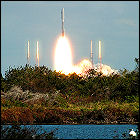 NASA launches the unmanned New Horizons probe on a course for the minor planet Pluto, the first spacecraft built to explore that destination. A trajectory with multiple planetary flybys and gravitational assists is designed to sling New Horizons toward Pluto within a decade (compared to Voyager 2’s 12-year trek to Neptune).
NASA launches the unmanned New Horizons probe on a course for the minor planet Pluto, the first spacecraft built to explore that destination. A trajectory with multiple planetary flybys and gravitational assists is designed to sling New Horizons toward Pluto within a decade (compared to Voyager 2’s 12-year trek to Neptune).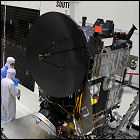 Having been “on hold” since October 2005 pending an audit of technical and managerial issues related to the mission, NASA formally cancels the Dawn unmanned mission to the asteroid belt. The spacecraft had been intended to lift off in 2006, using an ion propulsion system to visit, orbit, and map not one, but two, of the largest bodies in the asteroid belt between Mars and Jupiter, in the following decade. The mission is cancelled when NASA auditors find unresolved technical issues and project a budget overrun of 20%. Planners and managers for the Dawn mission plan to appeal NASA’s decision.
Having been “on hold” since October 2005 pending an audit of technical and managerial issues related to the mission, NASA formally cancels the Dawn unmanned mission to the asteroid belt. The spacecraft had been intended to lift off in 2006, using an ion propulsion system to visit, orbit, and map not one, but two, of the largest bodies in the asteroid belt between Mars and Jupiter, in the following decade. The mission is cancelled when NASA auditors find unresolved technical issues and project a budget overrun of 20%. Planners and managers for the Dawn mission plan to appeal NASA’s decision.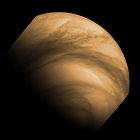 The European Space Agency’s Venus Express space probe – the first unmanned spacecraft to closely examine the second planet from the sun since the late 1970s – arrives at the planet to undertake a detailed study of the atmosphere, the unusually symmetrical cloud patterns of the planet’s north and south hemispheres, as well as observing the massive, hurricane-like vortices which remain over the poles. Venus Express also looks for the source of traces of sulphur dioxide in the Venusian atmosphere, which could be a sign that of active volcanoes on the surface.
The European Space Agency’s Venus Express space probe – the first unmanned spacecraft to closely examine the second planet from the sun since the late 1970s – arrives at the planet to undertake a detailed study of the atmosphere, the unusually symmetrical cloud patterns of the planet’s north and south hemispheres, as well as observing the massive, hurricane-like vortices which remain over the poles. Venus Express also looks for the source of traces of sulphur dioxide in the Venusian atmosphere, which could be a sign that of active volcanoes on the surface. NOAA’s GOES-13 Geostationary Operational Environmental Satellite is launched from Cape Canaveral into geosynchronous orbit to monitor weather patterns over the United States. It will be held in reserve until 2010, when it will be moved to the GOES-EAST position to replace GOES-12, which is suffering chronic attitude control thruster glitches. GOES-13 is yet another evolutionary step up in the GOES satellite hardware, but it will suffer its own share of hardware issues, including a series of inexplicable faults which will cause brief losses of weather coverage, and a later fault which disables infrared imaging capability. Some of these hardware failures will be attributed to micrometeoroid collisions.
NOAA’s GOES-13 Geostationary Operational Environmental Satellite is launched from Cape Canaveral into geosynchronous orbit to monitor weather patterns over the United States. It will be held in reserve until 2010, when it will be moved to the GOES-EAST position to replace GOES-12, which is suffering chronic attitude control thruster glitches. GOES-13 is yet another evolutionary step up in the GOES satellite hardware, but it will suffer its own share of hardware issues, including a series of inexplicable faults which will cause brief losses of weather coverage, and a later fault which disables infrared imaging capability. Some of these hardware failures will be attributed to micrometeoroid collisions.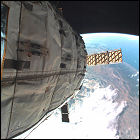 A scaled-down proof-of-concept model of an inflatible space station module designed by NASA in the 1990s, Genesis I is launched (with no occupants, or, indeed, an airlock to allow access) by Las Vegas-based Bigelow Aerospace. Genesis I is a testbed for a privately-operated space station whose pressurized modules (inflated from within by the supply of breathable air) would be much cheaper to launch than pre-fabricated structures such as the International Space Station. With several cameras monitoring every angle of the station, the module fully inflates in just ten minutes.
A scaled-down proof-of-concept model of an inflatible space station module designed by NASA in the 1990s, Genesis I is launched (with no occupants, or, indeed, an airlock to allow access) by Las Vegas-based Bigelow Aerospace. Genesis I is a testbed for a privately-operated space station whose pressurized modules (inflated from within by the supply of breathable air) would be much cheaper to launch than pre-fabricated structures such as the International Space Station. With several cameras monitoring every angle of the station, the module fully inflates in just ten minutes.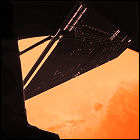 ESA’s unmanned Rosetta space probe, carrying the Philae lander bound for a 2014 rendezvous with Comet 67/P Churyumov–Gerasimenko, makes a gravity-assist flyby of planet Mars to alter its trajectory. As Rosetta will be only 160 miles from the Martian surface at its closest approach, the spacecraft is put into a safe mode for this critical part of its trip, and emerges unscathed. Its next gravity assist will come from Earth itself later in the year.
ESA’s unmanned Rosetta space probe, carrying the Philae lander bound for a 2014 rendezvous with Comet 67/P Churyumov–Gerasimenko, makes a gravity-assist flyby of planet Mars to alter its trajectory. As Rosetta will be only 160 miles from the Martian surface at its closest approach, the spacecraft is put into a safe mode for this critical part of its trip, and emerges unscathed. Its next gravity assist will come from Earth itself later in the year.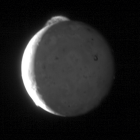 NASA’s New Horizons probe, on a one-way trip to become the first probe to swing past distant Pluto, picks up speed dramatically as it slingshots past Jupiter. New Horizons sensors are trained on the giant planet to get the first look at Jupiter since Galileo swan-dived into its crushing atmosphere. New Horizons gains nearly 9,000 miles per hour as it swings past Jupiter, which will put it at Pluto in July 2015. New Horizons’ camera catches an erupting volcano on Jupiter’s moon Io, spewing material 200 miles above the surface.
NASA’s New Horizons probe, on a one-way trip to become the first probe to swing past distant Pluto, picks up speed dramatically as it slingshots past Jupiter. New Horizons sensors are trained on the giant planet to get the first look at Jupiter since Galileo swan-dived into its crushing atmosphere. New Horizons gains nearly 9,000 miles per hour as it swings past Jupiter, which will put it at Pluto in July 2015. New Horizons’ camera catches an erupting volcano on Jupiter’s moon Io, spewing material 200 miles above the surface.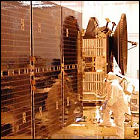 NASA reverses a decision made earlier in the month to cancel the asteroid-hopping Dawn mission, following appeals and assurances from the mission managers. Intended to use ion propulsion to visit to of the asteroid belt’s largest bodies, Dawn’s cancellation does have the effect of sliding the mission from a 2006 launch to a 2007 launch. The budget for the mission is expanded from $373,000,000 to $446,000,000, and arrival at its first target, the large asteroid Vesta, is still scheduled for 2011.
NASA reverses a decision made earlier in the month to cancel the asteroid-hopping Dawn mission, following appeals and assurances from the mission managers. Intended to use ion propulsion to visit to of the asteroid belt’s largest bodies, Dawn’s cancellation does have the effect of sliding the mission from a 2006 launch to a 2007 launch. The budget for the mission is expanded from $373,000,000 to $446,000,000, and arrival at its first target, the large asteroid Vesta, is still scheduled for 2011.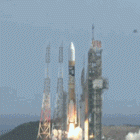 The Japanese space agency, JAXA, launches the unmanned SELENE (Selenological and Engineering Explorer) spacecraft to orbit Earth’s moon. SELENE is nicknamed Kaguya after a princess of the moon from Japanese folklore. Kaguya is scheduled to enter a polar lunar orbit in October, where it will conduct experiments in spectography, radio science, and charged particle and gamma ray detection. Though Kaguya has an on-board camera to map lunar terrain, the views for which it will become most famous will be shot by two HDTV cameras supplied by Japanese television network NHK, providing spectacular views of the lunar surface as they would be seen by an orbiting explorer.
The Japanese space agency, JAXA, launches the unmanned SELENE (Selenological and Engineering Explorer) spacecraft to orbit Earth’s moon. SELENE is nicknamed Kaguya after a princess of the moon from Japanese folklore. Kaguya is scheduled to enter a polar lunar orbit in October, where it will conduct experiments in spectography, radio science, and charged particle and gamma ray detection. Though Kaguya has an on-board camera to map lunar terrain, the views for which it will become most famous will be shot by two HDTV cameras supplied by Japanese television network NHK, providing spectacular views of the lunar surface as they would be seen by an orbiting explorer.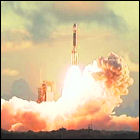 NASA launches the unmanned Dawn spacecraft, a vehicle designed to explore the two largest bodies in the asteroid belt between Mars and Jupiter. Dawn will also test a new charged ion propulsion system designed to improve on the performance of traditional chemical propellants (though its fine-tuning reaction control system will still use small engines powered by “rocket fuel”). Dawn is intended to visit and orbit the asteroid Vesta in 2011, which it will then depart after mapping to explore Ceres in 2015.
NASA launches the unmanned Dawn spacecraft, a vehicle designed to explore the two largest bodies in the asteroid belt between Mars and Jupiter. Dawn will also test a new charged ion propulsion system designed to improve on the performance of traditional chemical propellants (though its fine-tuning reaction control system will still use small engines powered by “rocket fuel”). Dawn is intended to visit and orbit the asteroid Vesta in 2011, which it will then depart after mapping to explore Ceres in 2015.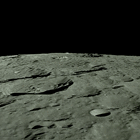 Japan’s unmanned Kaguya spacecraft, also known as SELENE, enters a polar orbit around Earth’s moon with an average altitude of 62 miles. Billed by Japanese space agency JAXA as the most significant lunar mission since the Apollo era, Kaguya carries numerous science experiments, though the public is most captivated by video transmitted back to Earth from two on-board HDTV cameras supplied by television network NHK. Kaguya conducts accurate gravitational mapping of the far side of the moon for the first time, and its own terrain camera obtains high-resolution mapping data, which will later be shared with Google for an online 3-D map of the moon.
Japan’s unmanned Kaguya spacecraft, also known as SELENE, enters a polar orbit around Earth’s moon with an average altitude of 62 miles. Billed by Japanese space agency JAXA as the most significant lunar mission since the Apollo era, Kaguya carries numerous science experiments, though the public is most captivated by video transmitted back to Earth from two on-board HDTV cameras supplied by television network NHK. Kaguya conducts accurate gravitational mapping of the far side of the moon for the first time, and its own terrain camera obtains high-resolution mapping data, which will later be shared with Google for an online 3-D map of the moon.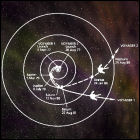 NASA’s Voyager 2 probe, having recently celebrated its 30th anniversary in deep space, sends back observations and instrument readings that lead scientists to a surprising conclusion: the “bubble” of the sun’s solar wind and magnetic influence isn’t spherical or even egg-shaped. Voyager 2′s readings, including the fact that it crossed what should’ve been the boundary of the sun’s outermost influence several times, have revealed that the solar system’s outermost boundary is in flux. Scientists theorize that the “dent” in that bubble is caused by the interstellar magnetic field of the Milky Way galaxy itself. Voyager 2 is now over 10 billion kilometers from the sun – or, to put that in perspective, 80 times further away from the sun than Earth is.
NASA’s Voyager 2 probe, having recently celebrated its 30th anniversary in deep space, sends back observations and instrument readings that lead scientists to a surprising conclusion: the “bubble” of the sun’s solar wind and magnetic influence isn’t spherical or even egg-shaped. Voyager 2′s readings, including the fact that it crossed what should’ve been the boundary of the sun’s outermost influence several times, have revealed that the solar system’s outermost boundary is in flux. Scientists theorize that the “dent” in that bubble is caused by the interstellar magnetic field of the Milky Way galaxy itself. Voyager 2 is now over 10 billion kilometers from the sun – or, to put that in perspective, 80 times further away from the sun than Earth is.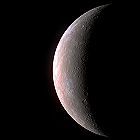 For the first time in over 30 years, a spacecraft from Earth flies past the innermost planet, Mercury. The Messenger space probe, launched in 2004, is due to take up an orbit around Mercury in 2011, but this first close pass – just over 120 miles above Mercury’s surface – is designed to alter its trajectory. Messenger carries little fuel, and has swooped past Earth three times and twice past Venus to use both planets’ gravity to change its heading. Two more close passes of Mercury will be needed before it finally becomes caught in the tiny planet’s orbit, where it will spend roughly a year mapping the planet’s surface and taking dozens of other measurements. The last space probe from Earth to visit Mercury was Mariner 10, which made three close passes in 1974/75. Despite the brief gravity-assist visit, Messenger captures its first 1,200 images of Mercury, including a side of the planet never before seen from Earth.
For the first time in over 30 years, a spacecraft from Earth flies past the innermost planet, Mercury. The Messenger space probe, launched in 2004, is due to take up an orbit around Mercury in 2011, but this first close pass – just over 120 miles above Mercury’s surface – is designed to alter its trajectory. Messenger carries little fuel, and has swooped past Earth three times and twice past Venus to use both planets’ gravity to change its heading. Two more close passes of Mercury will be needed before it finally becomes caught in the tiny planet’s orbit, where it will spend roughly a year mapping the planet’s surface and taking dozens of other measurements. The last space probe from Earth to visit Mercury was Mariner 10, which made three close passes in 1974/75. Despite the brief gravity-assist visit, Messenger captures its first 1,200 images of Mercury, including a side of the planet never before seen from Earth.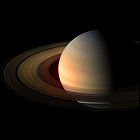 After four years orbiting the enormous ringed planet Saturn and flying past its dozens of moons, NASA’s unmanned Cassini probe still hasn’t seen it all. The four successful years thus far included releasing the European Space Agency’s Huygens probe to make the first ever landing on the large moon Titan, discovering (and flying through) water geysers over another moon, and exploring other moons that have puzzled scientists since they were first viewed up close in the early 1980s by the Voyager probes. The mission extension – called the Cassini Equinox Mission – gives Cassini an added two-year lease of life, with a $160 million price tag (the mission so far has cost both NASA and ESA a combined total of $3.3 billion).
After four years orbiting the enormous ringed planet Saturn and flying past its dozens of moons, NASA’s unmanned Cassini probe still hasn’t seen it all. The four successful years thus far included releasing the European Space Agency’s Huygens probe to make the first ever landing on the large moon Titan, discovering (and flying through) water geysers over another moon, and exploring other moons that have puzzled scientists since they were first viewed up close in the early 1980s by the Voyager probes. The mission extension – called the Cassini Equinox Mission – gives Cassini an added two-year lease of life, with a $160 million price tag (the mission so far has cost both NASA and ESA a combined total of $3.3 billion).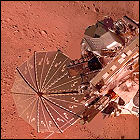 Radio signals from the Martian surface indicating the successful landing of NASA’s unmanned Phoenix probe near the north pole of Mars. (To put this feat in perspective: the past several unmanned probes to land safely on Mars used a “bouncing airbag” approach; the last time a lander actually made it to the surface intact with braking thrusters and landing pads – and no airbags – was in 1976, when NASA’s Viking 1 and 2 landers successfully touched down on the planet.) The first stationary (i.e. non-rover) Mars lander since the Viking probes of the 1970s, Phoenix will stay in one spot to conduct three months of studies. Also like the Vikings, Phoenix has a soil-sampling arm and an on-board laboratory to help it determine the presence of water or water ice in its polar vicinity.
Radio signals from the Martian surface indicating the successful landing of NASA’s unmanned Phoenix probe near the north pole of Mars. (To put this feat in perspective: the past several unmanned probes to land safely on Mars used a “bouncing airbag” approach; the last time a lander actually made it to the surface intact with braking thrusters and landing pads – and no airbags – was in 1976, when NASA’s Viking 1 and 2 landers successfully touched down on the planet.) The first stationary (i.e. non-rover) Mars lander since the Viking probes of the 1970s, Phoenix will stay in one spot to conduct three months of studies. Also like the Vikings, Phoenix has a soil-sampling arm and an on-board laboratory to help it determine the presence of water or water ice in its polar vicinity.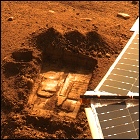 NASA’s Phoenix lander samples the soil of Mars, and it finds not only water, but an unusual soil composition which would make living off the land unlikely for human travelers. The soil sample in question contains perchlorate, a chemical used on Earth to make solid rocket fuel. So while a hypothetical Mars colony couldn’t use the planet’s own soil for farming, it could certainly launch a rocket or two. But missions scientists are quick to point out that while the presence of perchlorate in the Martian dirt may be unfriendly to humans, there may still have been life on the planet at some point which adapted to that chemical; it may also be a localized phenomenon unique to Phoenix’s polar landing site. (There are some plants on Earth capable of processing perchlorate-infused soil, but they’re generally not regarded as viable crops.) The Phoenix probe’s mission is extended to the end of September so it can continue its studies, and could be extended again at the end of that period, though the harsh Martian winter is likely to deny the non-roving Phoenix the kind of longevity enjoyed by its more mobile siblings, Spirit and Opportunity.
NASA’s Phoenix lander samples the soil of Mars, and it finds not only water, but an unusual soil composition which would make living off the land unlikely for human travelers. The soil sample in question contains perchlorate, a chemical used on Earth to make solid rocket fuel. So while a hypothetical Mars colony couldn’t use the planet’s own soil for farming, it could certainly launch a rocket or two. But missions scientists are quick to point out that while the presence of perchlorate in the Martian dirt may be unfriendly to humans, there may still have been life on the planet at some point which adapted to that chemical; it may also be a localized phenomenon unique to Phoenix’s polar landing site. (There are some plants on Earth capable of processing perchlorate-infused soil, but they’re generally not regarded as viable crops.) The Phoenix probe’s mission is extended to the end of September so it can continue its studies, and could be extended again at the end of that period, though the harsh Martian winter is likely to deny the non-roving Phoenix the kind of longevity enjoyed by its more mobile siblings, Spirit and Opportunity.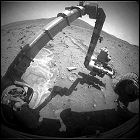 NASA’s Spirit Mars rover becomes stuck in an area of soft, dusty soil in which its wheels can no longer gain traction. Efforts to simulate the problem on Earth begin, as well as studies to see if Spirit can free itself, but attempts to wiggle or rotate the rover’s wheels on Mars produce no results (and eventually wear out the independent motor of another of its wheels). The attempts to free Spirit from its Martian sandtrap continue through early 2010.
NASA’s Spirit Mars rover becomes stuck in an area of soft, dusty soil in which its wheels can no longer gain traction. Efforts to simulate the problem on Earth begin, as well as studies to see if Spirit can free itself, but attempts to wiggle or rotate the rover’s wheels on Mars produce no results (and eventually wear out the independent motor of another of its wheels). The attempts to free Spirit from its Martian sandtrap continue through early 2010.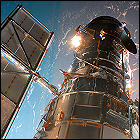 Space Shuttle Atlantis lifts off on the 126th shtutle flight, the final servicing mission to the Hubble Space Telescope (and the only post-Columbia flight not to visit the International Space Station). The repairs and upgrades conducted during a series of spacewalks will extend Hubble’s operation life through at least 2014. Aboard Atlantis for her 30th flight are Commander Scott Altman, Pilot Greg Johnson, and mission specialists John Grunsfeld, Michael Massimino, Andrew Feustel, Michael Good and Megan McArthur. This mission was nearly cancelled in light of post-Columbia flight rules requiring all shuttle flights to visit the space station.
Space Shuttle Atlantis lifts off on the 126th shtutle flight, the final servicing mission to the Hubble Space Telescope (and the only post-Columbia flight not to visit the International Space Station). The repairs and upgrades conducted during a series of spacewalks will extend Hubble’s operation life through at least 2014. Aboard Atlantis for her 30th flight are Commander Scott Altman, Pilot Greg Johnson, and mission specialists John Grunsfeld, Michael Massimino, Andrew Feustel, Michael Good and Megan McArthur. This mission was nearly cancelled in light of post-Columbia flight rules requiring all shuttle flights to visit the space station.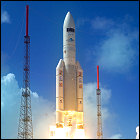 The European Space Agency launches a single Ariane 5 rocket to deliver a pair of unmanned space telescopes to the L2 LaGrange point trailing Earth. The super-cooled Herschel Space Observatory will search for objects at the far-infrared end of the spectrum, while the Planck Space Observatory will scan the microwave spectrum. Though both telescopes are sent to the same general region of space, they are entirely separate spacecraft which will operate independently of one another.
The European Space Agency launches a single Ariane 5 rocket to deliver a pair of unmanned space telescopes to the L2 LaGrange point trailing Earth. The super-cooled Herschel Space Observatory will search for objects at the far-infrared end of the spectrum, while the Planck Space Observatory will scan the microwave spectrum. Though both telescopes are sent to the same general region of space, they are entirely separate spacecraft which will operate independently of one another.